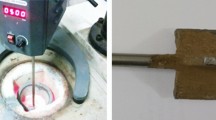Abstract
The effects of microstructure (namely, particulate volume fraction and particulate size) and the counterface materials on the dry-sliding wear resistance of the aluminum matrix composites 2014A1-SiC and 6061Al-Al2O3 were studied. Experiments were performed within a load range of 0.9 to 350 N at a constant sliding velocity of 0.2 ms-1. Two types of counterface materials, SAE 52100 bearing steel and mullite, were used. At low loads, where particles act as loadbearing constituents, the wear resistance of the 2014A1 reinforced with 15.8 µm diameter SiC was superior to that of the alloy with the same volume fraction of SiC but with 2.4 µm diameter. The wear rates of the composites worn against a steel slider were lower compared with those worn against a mullite slider because of the formation of iron-rich layers that act asin situ solid lubricants in the former case. With increasing the applied load, SiC and A12O3 particles fractured and the wear rates of the composites increased to levels comparable to those of unreinforced matrix alloys. The transition to this regime was delayed to higher loads in the composites with a higher volume percentage of particles. Concurrent with particle fracture, large strains and strain gradients were generated within the aluminum layers adjacent to contact surfaces. This led to the subsurface crack growth and delamination. Because the particles and interfaces provided preferential sites for subsurface crack initiation and growth and because of the propensity of the broken particles to act as third-body abrasive elements at the contact surfaces, no improvement of the wear resistance was observed in the composites in this regime relative to unreinforced aluminum alloys. A second transition, to severe wear, occurred at higher loads when the contact surface temperature exceeded a critical value. The transition loads (and temperatures) were higher in the composites. The alloys with higher volume fraction of reinforcement provided better resistance to severe wear. Wearing the materials against a mullite counterface, which has a smaller thermal conductivity than a counterface made of steel, led to the occurrence of severe wear at lower loads.
Similar content being viewed by others
References
M.K. Surappa, S.V. Prasad, and P.K. Rohatgi:Wear, 1982, vol. 77, pp. 295–302.
F.M. Hosking, F. Folgarportillo, R. Wunderlin, and R. Mehrabian:J. Mater. Sci., 1982, vol. 17, pp. 477–98.
K.J. Bhansali and R. Mehrabian:J. Met., 1982, Sept., pp. 30-34.
S.V. Prasad and P.K. Rohatgi:J. Met., 1987, Nov., pp. 22-26.
S.J. Lin and K.S. Liu:Wear, 121 (1988) 1–14.
C.P. You, W.T. Donlon, and J.M. Boileau: in Tribology of Composite Materials, P.K. Rohatgi, P.J.Blau, and C.S. Yust, ed., ASM INTERNATIONAL, Metals Park, OH, pp. 157-67.
Y.M. Pan, M.E. Fine, and H.S. Cheng: inTribology of Composite Materials, P.K. Rohatgi, P.J. Blau, and C.S. Yust, ed., ASM INTERNATIONAL, Metals Park, OH, 1990, pp. 93–101.
O.P. Modi, B.K. Prasad, A.H. Yegneswaran, and M.L. Vaidya:Mater. Sci. Eng., 1992, vol. A151, pp. 235–45.
A.T. Alpas and J. Zhang:Wear, 155 (1992) 83–104.
M.A. Martinez, A. Martin, and J. Llorca:Scripta Metall. Mater., vol. 28, (1993) pp. 207–12.
S.V. Prasad and K.R. Mecklenburg:Wear, 1993, vol. 162–164, pp. 47–56.
S. Das and B.K. Prasad:Wear, 1993, vol. 162–164, pp. 64–74.
A.G. Wang and I.M. Hutchings:Mater. Sci. Technol., 5 (1989) 71–76.
C.A. Caracostas, W.A. Chiou, M.E. Fine, and H.S. Cheng:Scripta Metall. Mater., 1992, vol. 27, pp. 167–72.
S. Wilson and A. Ball: inTribology of Composite Materials, P.K. Rohatgi, P.J. Blau, and C.S. Yust, eds., ASM, INTERNATIONAL, Metals Park, OH, 1990, pp. 103–112.
W. Wu, K.C. Goretta, and J.L. Routbort:Mater. Sci. Eng., A151 (1992) pp. 85–95.
B.N. Pramila Bai, B.S. Ramasesh, and M.K. Surappa:Wear, 157 (1992) pp. 295–304.
N. Saka and D.P. Karatekas: inWear of Materials, K.C. Ludema, ed., ASME, New York, NY, 1985, pp. 784–93.
A.T. Alpas and J.D. Embury: inWear of Materials, K.C. Ludema and R.G. Bayer, eds., ASME, New York, NY 1991, pp. 159–66.
A. Wang and H.J. Rack:Mater. Sci. Eng., A147 (1991) pp. 211–24.
J. Zhang and A.T. Alpas:Mater. Sci. Eng., 1993, vol. A161, pp. 273–84.
A.T. Alpas and J.D. Embury:Scripta Metall. Mater. 24 (1990) pp. 931–35.
Metals Handbook, 9th ed., ASM, Metals Park, OH, 1978, p. 148.
E. Rabinowicz:Compatibility Criteria for Sliding Metals in Friction and Lubrication in Metal Processing, F.F. Ling, R.L. Whitely, P.M. Ku, and M.B. Pcterson, eds., ASME, New York, NY, 1966, pp. 90–102.
F.P. Bowden and D. Tabor:The Influence of Surface Films on the Friction and Deformation of Surfaces in Properties of Metallic Surfaces, Institute of Metals, London, 1953, pp. 197–212.
A.T. Alpas, H. Hu, and J. Zhang:Wear, 1993, vols. 162–164, pp. 188–95.
J. Zhang and A.T. Alpas:Mater. Sci. Eng., A160, 1993, pp. 25–35.
M.B. Pcterson, L.K. Ives, and K.J. Bhansali: inMetal Transfer and Galling in Metallic Systems, F.I.D. Merchant and K.J. Bhansali, eds., TMS, Warrendale, IA, 1987, pp. 1–26.
K.C. Ludema:Wear, 100 1984, pp. 315–31.
I.V. Kragelskii:Friction and Wear, Butterworth and Co. London, 1965, pp. 88–94.
W. Hirst and J.K. Lancaster: The Influence of Speed on Metallic Wear,Proc. R. Soc, 1960, vol. 259A, pp. 228–41.
N.C. Welsh:Phil. Trans. R. Soc, 257A, 1965, pp. 31–70.
F.F. Ling:Wear, 1, 1957-1958, pp. 80–91.
A.P. Semenov:Wear, 4, 1961, pp. 1–9.
S.M. Kuo and D.A. Rigney:Mater. Sci. Eng., A157, 1992, pp. 131–43.
Author information
Authors and Affiliations
Rights and permissions
About this article
Cite this article
Alpas, A.T., Zhang, J. Effect of microstructure (particulate size and volume fraction) and counterface material on the sliding wear resistance of particulate-reinforced aluminum matrix composites. Metall Mater Trans A 25, 969–983 (1994). https://doi.org/10.1007/BF02652272
Received:
Issue Date:
DOI: https://doi.org/10.1007/BF02652272



